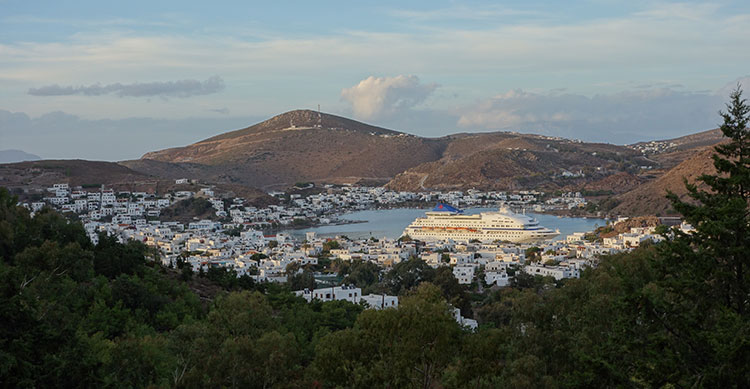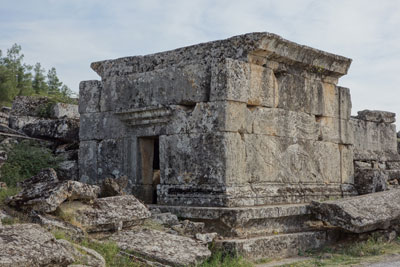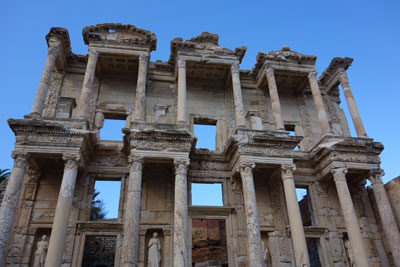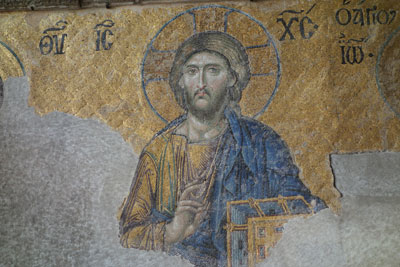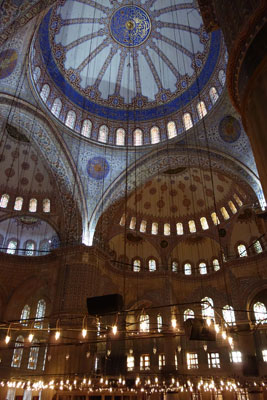Journey into antiquity: cruising the Greek Isles and Turkey
This article appears on page 6 of the May 2013 issue.
The idea of a trip that would visit Turkey and Greece — the eastern and western boundaries of a long-lost world that gave us Sappho and Sophocles, the “Iliad” and the “Odyssey,” and reached heights of scientific knowledge that went unsurpassed for two millennia — was thrilling. As my only previous contact with the classical world was through its literature, my October-November ’12 trip hosted by Louis Cruises afforded an opportunity to breathe the sea air of the Minoans and sail the Aegean to ancient ports, opening a gateway to a new perspective for me.
A bumpy start
Unfortunately, my first introduction to the cosmopolitan city of Istanbul involved spending a few hours in the Turkish Airlines baggage claim office trying to locate luggage that had been (incorrectly) checked through for the next day’s morning flight. But soon our group was on the freeway, passing sprawling shopping malls flanked by mosques, and the reality of being in a culture that was, at once, alien and very familiar washed over me.
As our van pulled up in front of our hotel, the Hilton Garden Inn, I was transported right back to the West — until I opened the curtains in my room to reveal a panorama of the Golden Horn, replete with a mosque on a hill.
Izmir to Pergamon
In the morning, we were off to the airport again. The flight from Istanbul to Izmir was surprisingly scenic, with hunched hillsides exposing their spines studded with wind turbines.
Exiting the airport, we boarded our coach and were whisked off toward our first site, the ancient city of Pergamon. Along the way, our guide, Ahmet, gave us a jovial overview of Turkish geography, history and politics.
Despite years of reading about the ancient world and days of looking at ancient artifacts preserved behind glass at New York’s Metropolitan Museum of Art, I wasn’t quite sure what to expect as we climbed the sloping hill littered with ruins. One of the group members, an inveterate traveler, advised me to look down to another slope.
“See that marble foundation? If you ever go to Berlin, the temple that used to be here is on display there,” she said.
It was a clear day, and I began to walk down the steep stairs at the entrance to the theater. As I descended the staircase, the modern town of Bergama unfolded to my left.
Suddenly, a call to prayer filled the valley. I could see only one mosque from my vantage point, but the haunting song was everywhere.
I had heard the call to prayer from time to time during my trip, but in the pleasant cacophony of Istanbul it had just blended into the background. Here, it was the only sound to be heard.
As I reached the base of the theater, there were plaques indicating where a temple, long vanished, once stood. At that moment, I was astonished to be standing alone in a theater where plays were performed two millennia ago.
After exploring the acropolis, we descended the mountain to the Asclepium, an ancient healing site dedicated to Asclepius, the Greek god of medicine. The path to the site was lined with columns of various heights, a prelude to the thicket of interesting architectural fragments on display farther along.
Pamukkale
Following an overnight at the Hilton Izmir, a grand skyscraper in the downtown area, we rolled out onto Izmir’s broad highways bound for Pamukkale, the “cotton castle.”
Before visiting the travertine pools, however, we proceeded up the hill to the ancient city of Hierapolis. The group had the option of taking a sort of overgrown golf cart up through its necropolis, but it was such fantastic weather that a few of us decided to walk up.
The stone coffins were so great in number that I eventually stopped taking pictures. Some of the more ornate tombs were open, so visitors could venture inside. There were very few people out, despite the excellent weather, and the city was nearly deserted as we approached the Frontinus Gate and the main street of Hierapolis.
Upon reaching the end of the road through the necropolis, the full hillside of calcium springs became visible, shining white in the sun. Some of us took off our shoes and carefully walked through the warm water. Many people were swimming in the numerous pools, which the visiting children seemed to find the most novel.
Fearless tourists who got too close to the edge of the cliff for photos were shooed away.
There were wooden steps that led to the spring, and it was relaxing to put my feet in and look out over the picturesque valley.
On to Kuşadası
We piled into the bus after our full day of sightseeing, and one of the more cantankerous tour members began chanting, “Vodka!,” so our gracious hosts made an effort to procure raki, the national drink. (And an effort it was, as we were in a relatively rural area of a predominantly Muslim country.) The drink had an anise flavor, similar to that of Greek ouzo, and was consumed much the same way, with water.
Completely exhausted by the time we reached Kuşadası, we dutifully went up to our rooms at the Charisma De Luxe Hotel. Searching for my room in the dark hallway, I wasn’t expecting much, but I was surprised to find that each room had a balcony looking out onto a massive pool and deck that faced the Aegean.
Later, our group spent some time on the lower deck, which was right at sea level. We could see that a storm was approaching, which made us apprehensive about our visit to Ephesus the next day, but it turned out to be the kind of storm that rolls in, blasts rain and thunder with magnificent bravado and is over in a few hours.
I had the most relaxing night of the trip here, leaving the sliding glass balcony door open to the balmy night and falling asleep to the sound of the waves.
Ephesus
In the morning, there was palpable electricity in the air as we boarded our coach to Ephesus. My seatmate for the ride, a traveler who had visited the ruins more than 20 years before, delivered, with a sly glance, the supreme understatement “You’ll really enjoy Ephesus. It’s something to see.”
We wound through the sunny, auburn hills and were dropped off at the entrance to the site. It was overflowing with thousands of tourists. We all had noticed the massive Celebrity Cruises ship that had pulled into the harbor the previous night, but we had hoped for the best.
My friend who had visited previously was shocked at how much more of the city had been unearthed. Our tour guide pointed to a change in the color of the vegetation that formed a line around the top of the valley and explained that in that zone was the former boundary of the city. Only about 20% of the site has been excavated.
Despite the crowds and the dozens of tour guides speaking over each other in French, Spanish, German and Japanese, Ephesus was, bar none, the finest ancient city ruins we toured. The polyglot crowd had an odd degree of authenticity to it, as, surely, in antiquity the 250,000 people milling about in the city’s heyday would not all be speaking Greek (or, later, Latin).
In addition to the city, we toured the former homes of its wealthy citizens, which were preserved in fantastic condition, full of mosaics and frescoes.
Flowing with the crowd through the sprawling, half-reconstructed ruins, we stopped to marvel at the fantastic façade of the library.
Louis Cristal
Fresh off the bus from Ephesus, we met our ship, Louis Cruises’ Louis Cristal. Moored across from a Celebrity megaship nearly twice its size, the Cristal seemed at first glance to be on the scale of a tall ship. However, once I took the elevator to the ninth deck, it was startlingly high.
Having gone through more than its fair share of remodels, the Louis Cristal is a real-world “ship of Theseus,” but its most recent renovation made it an excellent floating hotel. I even took a dip in the pool on a particularly balmy day.
The food in the main dining room was consistently tasty. The one night we dined in the premium dining room, I was served a meal that went far above and beyond my expectations. I was glad we had many stairs to climb at our next stop, Patmos, to work off those calories.
We arrived at the charming island of Patmos just before dusk. The bus climbed the hills from the port and dropped us off as close as we could get to the Monastery of Saint John the Theologian. Then our group walked the rest of the way up the tiny cobblestone street, which made our arrival at the monastery gates that much more dramatic. Above the entrance to the monastery, where photos were not allowed, was a fantastic mosaic.
The interior of the monastery was decorated with spectacular icon paintings. Despite their keeping the lights low to protect the art, I could see that the monastery was full of masterpieces.
Rhodes
One of the highlights of the trip, at least in my mind, was that we would spend Halloween at the acropolis of Lindos on the island of Rhodes. Thankfully, the weather was superb.
As we followed our guide through the maze of streets, she informed us that the roads in Lindos were designed to lead in circles to repel invading pirates.
Following our exploration of the acropolis, which offered fantastic views of the sea and city below, a few members of the group settled into a little crêpe restaurant for lunch. Then our group was dropped off just outside the gates, and we reached the Grand Master’s Palace on foot.
We walked along the bridge through the first massive moat and through ironclad doors, then continued along a tree-lined pathway to the inner sanctum. The medieval castle, parts of which were under renovation, had a collection of Roman statues in its courtyard and an interesting museum in the castle building, itself. Our guide discussed the various theories of where the Colossus of Rhodes could have stood.
We walked down the cobblestone Street of Knights to the center of the Old City, where we had a leisurely dinner at the pleasant Alexis Four Seasons restaurant, which later let us visit its rooftop for panoramic views of the walled city.
Crete and Santorini
As a child, I had read the myth of the Minoan labyrinth, so our visit to the Palace of Minos near Knossos, on the island of Crete, was especially fun. We learned that the colorful frescoes had been re-created in modern times. Still, the palace was remarkably preserved.
As the Louis Cristal approached Santorini, I realized our luck in terms of weather had run out. Dark clouds dotting the sky and heavy humidity seemed to suggest an imminent drizzle.
Undaunted, we left the ship by tender and, once on land and aboard our bus, began the dizzyingly steep climb up the hill, switchback by switchback. At the point where it seemed like we were going to leave the Earth behind and shoot up into space, we emerged onto a plateau of rolling hills punctuated by the island’s famous whitewashed windmills.
Our destination was not the town square but the sprawling archaeological site of Akrotiri. The site had been closed to visitors following the collapse of its roof in 2005 but had reopened to the public just a few months before our trip.
The ruin, associated with the Minoan civilization, was buried in a volcanic eruption around the second millennium BC. Curiously, no bodies were found in the ruins, so the residents of the island may have evacuated before the actual eruption took place.
After dinner on the ship, I returned to the back deck to watch the tenders go to and fro in the night. The pleasant glow of lights scattered along the edge of the cliff began to recede as we left the island behind.
Athens
Our short visit to Athens was on everyone’s minds since we had begun to cruise the Greek Isles. We had only a few hours scheduled in the city, but those were to be spent at the Acropolis Museum, which seemed to have been built for the sole purpose of shaming the British Museum into repatriating the Elgin Marbles. Given that the marbles have been on display in London for 197 years, repatriation seems unlikely.
A cursory glance around at the myriad treasures in the place was enough to know that we wouldn’t really have time to savor our experience there. A few of the group members decided to go up to the terrace on the top floor, have some espresso and gaze at the real Acropolis just across the way.
We boarded the coach back to the ship with the satisfaction that we had had a pleasant, if brief, taste of this beautiful city.
Istanbul redux
It was bright and warm outside, so I went out to the sundeck to take in the coastline, punctuated by the massive interisland ferries moored across the harbor. Eventually, we began to pull out of the harbor to begin our final overnight cruise back to Istanbul. Having already seen the panorama of the city unfold, we were excited to see inside the massive buildings we had glimpsed days before.
The Port of Istanbul, a hub of activity much as it must have been thousands of years ago, was home to an astonishing array of ships. The most nimble dancers in this carefully orchestrated aquatic cotillion, the pleasure crafts, ferries and sailboats, danced at a frenetic pace around the slower supertankers, container ships and trawlers.
Seen through the panoramic windows of the bridge, where we had scheduled a visit with the captain, the ships sailing every which way against a backdrop of skyscrapers, mosques, bridges and palaces capsulized the ceaseless sense of motion in Istanbul.
We debarked and proceeded directly to the main event: Hagia Sophia. I had seen pictures of this former church and mosque, but nothing compared to being in the center of such a massive, ornate building.
Archaeologists have uncovered many of the Christian-era mosaics that had been plastered over when the church was converted to a mosque in 1453. Wandering around the building, it was easy to be overwhelmed with the decorations covering every surface.
Already in awe of Hagia Sophia, we walked the couple of blocks to the entrance of Topkapı Palace, the primary residence of the Ottoman sultans for around 400 years. Photography was not allowed, but even if it were, nothing could capture such extravagance. Every item was covered in gold and precious gems like a lavish noveau riche fantasy.
The temple complex, some of which unfortunately was obscured with scaffolding, was pleasant and full of greenery.
Blue Mosque
Leaving Topkapı Palace, having passed through a display of Ottoman treasures, we lunched al fresco at a restaurant that hugged a terrace of the palace complex. The view only accentuated the excellent food.
I was pleasantly surprised that we were served a signature Greek item, dolmas (stuffed grape leaves), and was beginning to notice the similarities in Greek and Turkish cuisine. Our guide explained that even Turkish coffee was available in Greece. (However, in Greece it’s called Byzantine coffee.)
The group readied cameras upon entering the Sultan Ahmed Mosque, also known as the Blue Mosque. I had never had occasion to enter a mosque, but our guide filled us in on the routine.
Yes, the smell of feet was just as bad as we had been told. However, the intricate tile work was incredible to see. My gaze followed the jumble of golden Arabic inscriptions, floral motifs and complex geometric designs while the congregation, paying no mind to the grand surroundings, made their way to the men’s and women’s prayer areas. The mosque was preparing to close, so we took in as much of the grand building as we could before donning our shoes at the exit.
Bazaar experience
We departed the mosque and headed to our final two sites on the trip, the Grand Bazaar and the Spice Bazaar. I’m not much of a shopper, and throughout the trip I was very skeptical that the thousand-plus nazar (evil eyes) we had seen during the trip didn’t come straight from China, so I thought I’d save my shopping for the bazaars.
While the Grand Bazaar had amazing architecture and a large number of shops, it didn’t seem to have much for sale that was one of a kind. I found that the shops on the boulevard leading up to the Grand Bazaar had many items of higher quality than the shops actually inside it.
In contrast, the Spice Bazaar had all sorts of interesting items.
Our final dinner was at a restaurant on an island in the Bosphorus that was reached by small ferry. The place was full of suited hommes d’affaires and stiletto-wearing women who looked as if they all had just walked out of a Russian fashion magazine.
Our dinner of course after course of Turkish fare was irresistible. Exhausted, we soon retired to the excellent Point Hotel Taksim to take a catnap before our flight back to the States early the next the morning.
At the end of my trip, I wondered if I understood this part of the world better, but I had far too brief a stay in either country to know for sure. Months later, I felt honored to have seen the hills and walked the same streets that the ancient Greeks had — through their theaters, their houses, their pantries, their graves — for a glimpse of the West's ancient roots.
While the Louis Cristal is not currently scheduled to sail a similar itinerary in 2013, Louis Cruises is offering a 4-night “Jewels of the Aegean” cruise on which the “Louis Olympia” visits Mykonos, Kuşadası, Rhodes, Patmos, Heraklion and Santorini. Weekly departures are priced from $659 per person for an inside cabin and from $769 for an outside cabin.
Arthur Hanna was the guest of Louis Cruises (Cyprus; phone +30 210 4583400, www.louiscruises.com) and their ground operator Karavan Travel.

